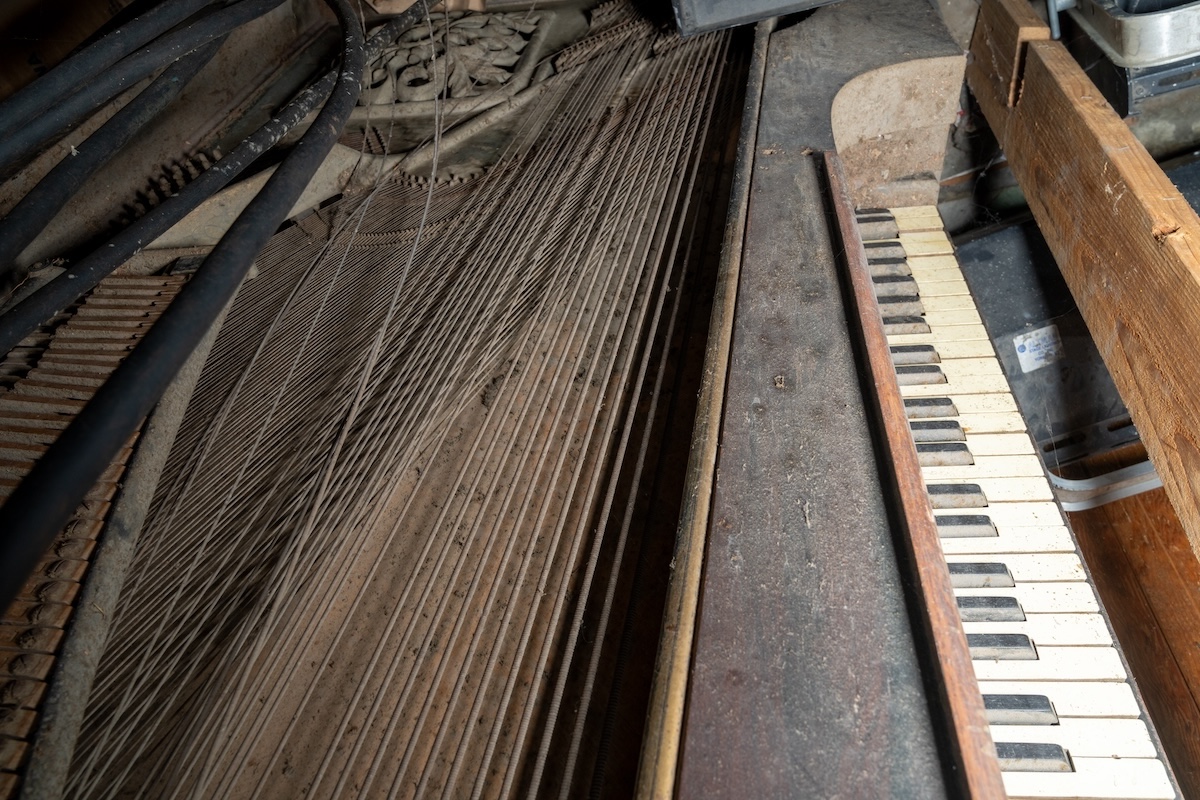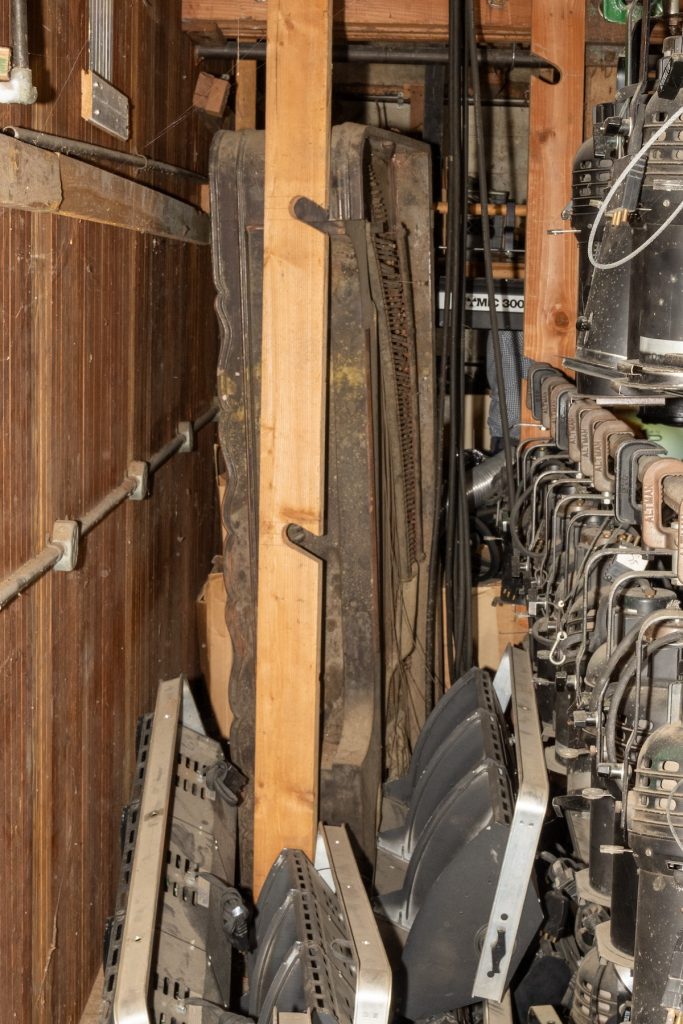The Lobero Piano

Silently listening, a 150-year-old piano has been hidden in the bowels of the Lobero Theatre in a coffin-shaped box standing vertically in wedge of a corner, without legs, a lid, or a keyboard cover. The once beautiful rosewood case and once fine ivory keys identify this ghost as a piano, secreted behind racks of heavy metal bars from which hang large, outdated klieg lights and suspended cables. If Brett Hodges, Lobero historian and board member, hadn’t pointed out the piano to me I would not have seen it. Even when he pointed it out, with a powerful flashlight all I could see was rusted, dirty strings and a slight hint of a gold iron harp. Even the staff there with us that day didn’t know of its existence.
The piano has heard every sound in that theater for one hundred years. With good enough ears, those of us in the Lobero basement that day might have heard the piano vibrating in response to the band rehearsing above us on the stage above its hiding place. And the piano may still make music of a kind; I struck a key and heard an eerily deep-toned note. Although it has not been played, it has been singing with resonant frequency for years: any instrument nearby that plays a certain tone would be ‘matched’ by one of these old piano strings, because that string will have absorbed the energy of the sound – and would amplify its own vibration. The old square grand piano, truncated, rejected, immobile, has been singing along with the stage performers above for untold years.

I was helped in the identification of this virtually unrecognizable instrument by Michael Stinnett, founder and director of Sales and Historical Archives at the Antique Piano Shop, experts in those coffin-shaped old pianos called Square Grands. Viewing pictures of this instrument’s massive harp, decorative sound vent, and curling enameled flourishes, Stinnett said the piano was created in Boston at the end of the Civil War by T. Gilbert and Company. More American square grand pianos were built and sold than any other shape, such as a vertical or a concert grand, until 1880-1890 when the honky tonk upright took the lead. At that time, the square grand went out of fashion, seen as a reminder of the Victorian Gilded age. But years before electrical amplification and player pianos the mighty, weighty iron harp of the square grand could handle more direct string tension than any other model of piano, and was therefore louder; most classical nocturnes and piano concertos were composed on a pianoforte that had a tone similar to the late 18th and 19th c. square grand, which for 150 years was the choice for the European or American front parlor. Like all square grands, the Lobero’s ghostly piano has strings running left to right; those are visible today with no small feat of body maneuvering. The piano is stored on its side end with the keyboard running down the corner of a wall.
With origins as an opera house and a premier stage for music, the Lobero and pianos have had a long association; the play performed for the opening of the theater in 1924 by the Santa Barbara Community Arts Players was abouta pianist and a piano, called Beggar on Horseback, by George S. Kaufman and Marc Connelly. The heart of the play involves the young struggling classical pianist and composer Neil McRae, and is set in his Greenwich Village cold water flat, sparsely furnished with the look of a poor artist’s room on the third floor of a brownstone – McRae has a treasured old piano. The stage directions say “the most luxurious piece of furniture in the room is a grand piano which McRae has hung onto with no little difficultly; it stands well downstage left… downstage right is the only comfortable piece of furniture, an easy chair, the rear wall holds McRae’s desk and straight stiff-backed chairs…”
This was the play that was chosen by the Arts Players and director Nina Moise to open the “new” Lobero on August 4, 1924. Moise had come to Santa Barbara by way of Provincetown Players and Hollywood in 1920 to direct plays for the Potter Hotel Theatre. Moise had heard of the hit production Beggar on Horseback on Broadway in New York, and was commissioned by the Arts Players to speak to the owner of the play, Winthrop Ames, with the request that his major Broadway hit be commensurately performed in a community theater in a small town, Santa Barbara. On the night Moise was viewing the play, it would have gone on for 223 performances at the Broadhurst Theatre, and then revived seven months later at the Schubert. The question: would Winthrop Ames give the production rights and stage designs to Moise, who was one of only 18,000 people living in Santa Barbara in 1924 (today we are 90,000 people) and perhaps a tiny audience, to be performed by amateurs at a new theater? The answer was yes: Ames had vacationed in Santa Barbara and had loved the place.
I had a thought that since this piano has been hidden away and never sold, it may have been the piano that opened the “new” Lobero in Beggar on Horseback. Piano historian Stinnett described it as a top piano for its day but affordable for a struggling classical pianist like the character McRae in the 1920s. The square piano went out of fashion before 1900, so they quickly became very unpopular and were inexpensive to acquire. Someone who loved the sound of a large grand piano without the means to purchase a concert grand would have likely chosen a square piano since they were cheap and plentiful at the time.
The ghostly piano may well have been the character McRae’s piano in 1924. An article in our Historical Society’s Noticias by Reginald Faletti of 1965 describes the first production at the Lobero in 1924 in detail; local artist Robert Wilson Hyde (1875-1951) had loaned the Lobero his antiques and fine items from his studio and antique shop located in the Hill-Carrillo adobe on East Carrillo Street. In the early 1900s Hyde was becoming a major figure in the Arts and Crafts Movement; he was co-founder of the Community Arts Association and also the 1920s Santa Barbara School of the Arts. He was instrumental in the founding of the “new” Lobero in 1924, and acted as set designer for the theater. Could the piano have been once in his antique shop? Was it his gift?
The piano was central to the action on stage in Beggars on Horseback as the stage direction calls for the leading man McRae to play for a dream sequence in the play, an exotic pantomime with music composed by McRae. Director Moise was fortunate in her choice of leading men: young Arthur Bliss, a concert pianist, had recently arrived in California from England with his father; it was Bliss that expertly played “A Kiss in Xanadu,” set in an exotic royal bedchamber behind a moonlit balustrade with flowers in the moonlight as a play within the play. Critics at the time thought Bliss an extraordinary talent: the amateur went onto compose music for the Hollywood Bowl in 1950 and was knighted by the King of England for his contributions to music.
Faletti’s 1965 article about Opening Night August 4, 1924, states that it wasn’t just the repeatedly packed houses for Beggars on Horseback that wowed, but that the whole ambitious endeavor of the building of the theater, the mounting of a Broadway production by small town amateurs, and the support of the local arts community that was a landmark moment for theater in the USA. He quotes the magazine of the day, which had printed a fundraiser for the Lobero, The Little Theatre Monthly: “The play achieved a climax, demonstrating the extraordinary resources of the playhouse, the director, and the actors of the Community Arts Players who are amongst the ablest and most progressive amateur organizations
in the country.”
If the Lobero piano could talk, and we could hear that abandoned ghost – the voice of the upended, ravaged piano that sleeps wordlessly in the dark of the (apocryphally) haunted basement of the Lobero – it may tell us that it had been witness to this climatic moment in Santa Barbara history, the opening performance of the Lobero. The piano has certainly sung about the occasion ever since.







You must be logged in to post a comment.